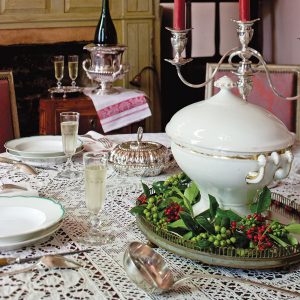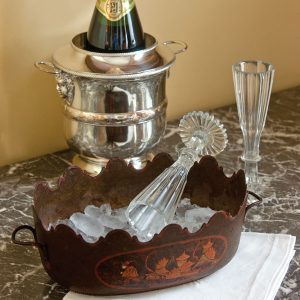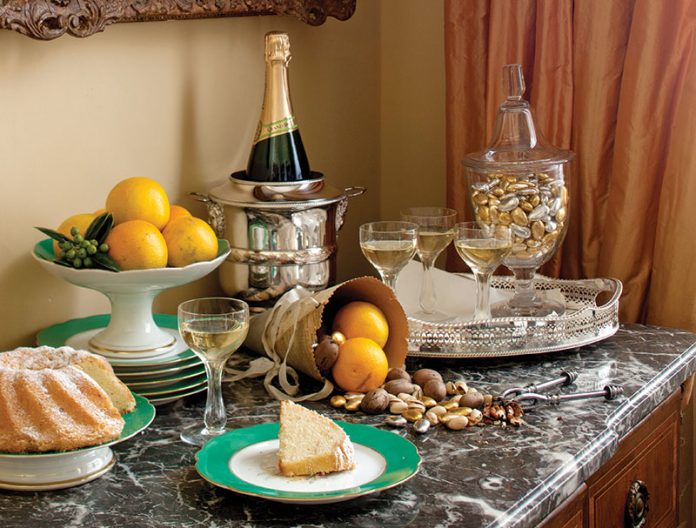by Patrick Dunne
Some words roll out rich as cream cake, and Réveillon is one of them. For as long as the French language has been spoken in these parts, Réveillon has referred specifically to a late evening celebration popular among Creoles on the eves of Christmas and New Year’s. Recently, an extended version of this holiday fête has again become popular, especially in Louisiana restaurants. The word, which means “reawaken,” also incorporates the root rêve, which translates as “dream.” For anyone who has experienced a Christmas Eve Réveillon held in the pre-dawn hours after Midnight Mass, it does have a dreamlike quality.

Can there be truly great anticipation of a feast without first a fast? Perhaps for the modern reveler, but in the traditional world—the world of my childhood—December 24 was a kind of sweet torture. We were not Creoles but lived in that Creolized band of Gulf Coast culture where rituals and recipes were not far afield from many households in Louisiana. Christmas Eve was a day of no meat and very small meals. Meanwhile, the sideboard was being piled high with pies and cakes, pralines and divinity. Stuffings stirred up in big skillets were fragrant with sausages and spicy liver, none of which could be tasted until past midnight. Our early supper on that night of nights was invariably a modest oyster soup cooked in butter and milk, accompanied by cornbread that had been baked earlier for the dressings. What a poor preview of what was to come! It happened that my father was born on Christmas, and his birthday party was always held after Midnight Mass with a Réveillon supper that seemed to a child’s fantastical eye as close to a castle banquet as I could imagine.

The old Louisiana Réveillon menus usually featured a spicy duck gumbo or turtle soup, almost always daubes and ham and plenty of other savory and sweet concoctions. No one knows the litany of dishes better than Chef John Folse, with whom I love to trade stories. My family had our own variations, but one thing did not change—the high golden-colored sunshine cake with almond-flavored icing, enthroned on the family cake stand. Part of our Réveillon ritual was driving to a ramshackle part of town where Miz Hattie Little lived. Guardian of a recipe my father was sure no one else could imitate, she made a cake for each birthday since his youth. Even in her ninety-ninth year, neither my father’s charm nor his crafty generosity could pry out the ingredients. With each entreaty, she would pat his cheek and promise to make another next year, “God willing.”

While eggnog was a popular drink for 19th-century Réveillons, so was Champagne. This sparkling wine hails from the Champenoise region near Reims, where all the French kings went to be crowned, and hence has always had an aristocratic aura. Of course, this intimation of grandeur appealed to Creole sensibilities, and for this night alone children were sometimes allowed to have a small taste.
The popularization of Champagne was an evolutionary affair. That old monk Dom Perignon carefully achieved the clear golden wine, but the English ingeniously produced glass bottles strong enough to hold the fermentation without bursting. It seems that Seigneur Charles Saint-Évremond, a hedonist on the run from prosecution in France, brought with him in exile across the Channel the French style of enjoying the bubbly drink. He also introduced the flute-shaped glass, the style of which changed as tastes changed throughout the centuries. By the 19th century, Champagne flutes got a little larger and more decorative, incorporating knops, cutwork, engraving, and fluting. Some stems were hollow to catch the rhythm of the effervescence and were called impossibles in France. Fashion, the most relentless of all instincts, eventually dictated that edgy hostesses serve Champagne in broad-mouthed saucers on stems called coupes. These had the “advantage” of permitting the more rapid evacuation of the bubbles, supposedly enhancing the taste and making ladies less susceptible to sneezing. Where exactly this new style started is still uncertain, probably with a novelty-seeking party giver. A few late 19th century English writers claimed the first coupe was modeled on the bosom of that “degenerate” queen, Marie Antoinette, but like many historical insights by the English, this was based on groundless prejudice and unreliable slanderous propaganda from the French Revolution. In fact, the coupe was a re-adaptation of a Venetian form that had been around for a long time.
Lafcadio Hearn, one of the earliest writers on la cuisine Creole, claimed Champagne was drunk in the middle of the meal with an entrée. Whenever it was enjoyed, and whether in coupes or flutes, few Réveillon tables were complete without Champagne. For bon vivants here in Louisiana, the same is true today.
Patrick Dunne is the proprietor of Lucullus in New Orleans, which boasts an international clientele because of the unique emphasis on antiques, art, and objects with a culinary connection. He is the author of The Epicurean Collector and a sought-after lecturer on table style and food history.





